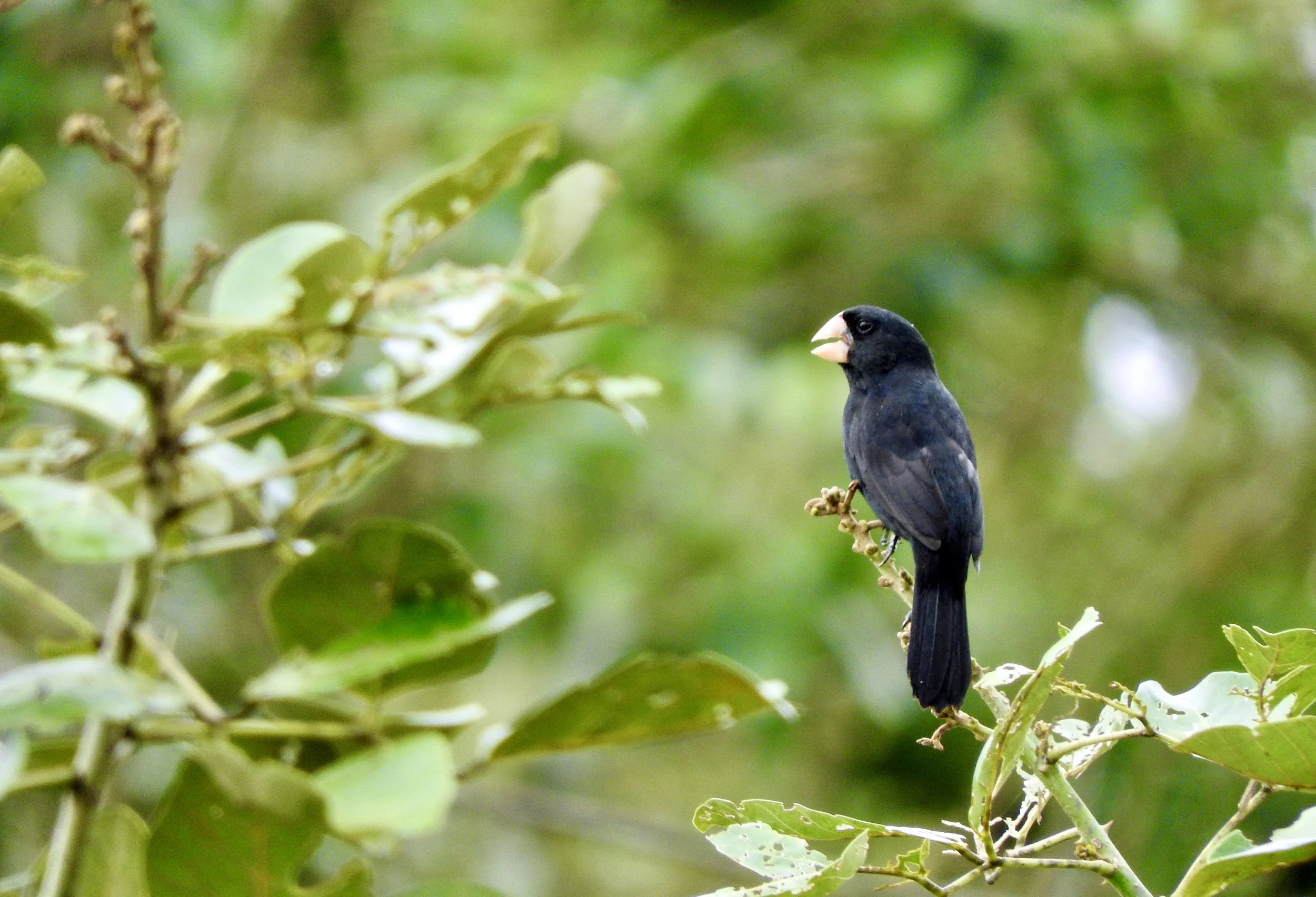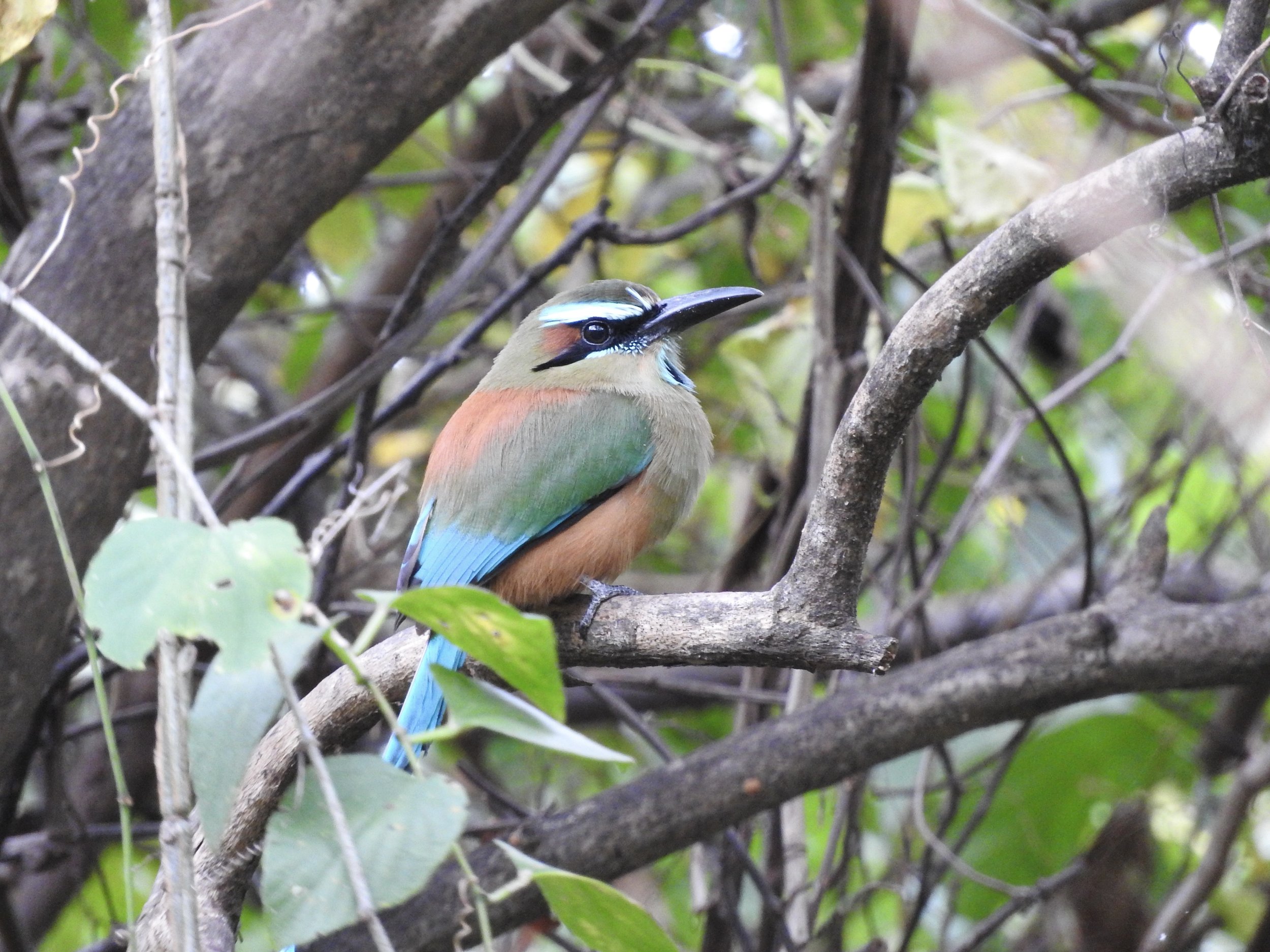Birding Costa Rica: Caño Negro and La Selva feat. a long drive
Nicaraguan Seed-Finch
In Part Five of Chris’s Costa Rica birding diary, the birding gods smile on the group with a mind-blowing morning’s birding at Caño Negro Wildlife Refuge, and a surprise stopover at one of the most iconic birding locations in Central America leads to even more lifers.
Three Hours, 132 Species
After a successful afternoon at Medio Queso Wetland a day earlier, I was excited to see what our morning's birding at Caño Negro National Wildlife Refuge had in store. I've always been a big fan of wetland and coastal birding - I think it's something to do with my birding roots in Britain, where a lot of our birding happens at marshes and coastal mudflats. So Caño Negro was another excellent opportunity to spot aquatic birds in Costa Rica.
Once again, the weather gods weren't smiling on us. However, they weren't exactly scowling at us either, more like frowning, so we headed down to the docks early to a panorama of grey skies and drizzle. Not lousy birding conditions, but far from ideal. However, we were fast getting used to challenging weather and had even begun to thrive off it as a group. "We only see good birds in bad weather" quickly became our mantra.
As on the previous day, though, once we set off, the drizzle abated, and we were able to bird from the open front of the boat without issue, thankfully. What followed was easily one of the best mornings of birding I've ever had, as we tallied an astonishing 132 species between us over just three hours of birding!
The morning began promisingly with a distant view of a female Snowy Cotinga. We saw Snowy Cotinga during our Birders Show shoot in Bocas Del Toro, Panama, just a couple of months earlier. They were also the duller colored females; I'm still waiting on my first adult male Snowy Cotinga. One day!
The Agami Heron
Then the real action began, and it came thick and fast. I was sitting on the boat's prow as we turned into a narrow channel. I noticed a partially-obscured bird with a long bill stalking along the shallows through the undergrowth. After a split second, I registered it was our main target species: the Agami Heron. I whisper-shouted "Agami" and gestured hurriedly you our captain Chambita to stop the boat. It was a superb view of one of the world's most beautiful herons; it calmly fished along the bank just meters from our boat, showing off its deep-purple plumage and silvery neck plumes. Its dagger-like bill was put to good use as it skewered a fish in the muddy channel before flying off downstream.
Birding Fact: the Agami Heron (Agamia agami) is the only member of the genus Agamia, and is sometimes called the Chestnut-bellied Heron. The name ‘Agami’ comes from a Cayenne Indigenous work from French Guiana, meaning a forest bird, presumably due to this heron’s preferred habitat of forest streams and swamps. In Brazil, it is sometimes called the Soco beija-flor, or ‘Hummingbird Heron,’ due to its color pattern.
My blurry, low-light photo of the Agami Heron: it was the best I could do…
I've been fortunate enough to see Agamis at a colony in northern Colombia, but this was a huge target nonetheless and a lifer for several group members. Just a few more bends down the channel, and we caught up with another big target bird: the elusive Green-and-rufous Kingfisher. A Belted Kingfisher further along the river meant that we had spotted all six kingfisher species in the Americas at Medio Queso and Caño Negro!
A Tiny Tennis Ball with Legs
We continued birding the forest edges along the river channel, catching up with some nice mixed flocks containing a nice mix of species, including my lifer White-collared Manakin and a pair of Bare-crowned Antbirds. Once we were satisfied with the river birding, we moved to a lake to try for our other big target, the shy and hard-to-see Yellow-breasted Crake.
After a brief pause for Jeff's lifer Black-collared Hawk, we arrived at the marshy fringes of the lake where the crakes can be found. Our guide played a snippet of the call, and eventually, a couple of crakes answered in from the reeds. Little by little, they came closer, until one individual broke cover and gave us wonderful views. I've heard the crake described as a tiny, fluffy tennis ball with legs, which was a pretty apt description. Our group member, José Castaño was the most alert with his camera and managed an excellent photo.
José Castaño showing off his excellent image of the Yellow-breasted Crake
After a genuinely astounding few hours of birding, we headed back to our hotel for breakfast (that's right, we had registered 132 birds before breakfast!). Today was the longest traveling day; by nightfall, we would drive almost 6 hours and cover about half the length of Costa Rica to arrive in Cartago Province. So we had to get moving!
The good news was that we had no deadline for arrival, except maybe dinner, so we could bird the road. I haven't mentioned it yet on this blog, but our group had gelled well from the start, and long drives held no fear: we grabbed a crate of beer from a local store and fired up our Spotify playlist. Lots of Wayne's World-style headbanging to Queen usually ensued.
Nicaraguan Seed-Finch
Early on in the journey, we stopped to bird a short section of road not far from Caño Negro. We still had one big regional target to tick off, and we got it right away here: Nicaraguan Seed-Finch. A few months earlier, this species had been a distant lifer for me along the Snyder Canal in Bocas Del Toro (you can see that bird on this Birders Show episode). Still, this view was far superior - the smart, black bird perched out singing in the open, a jumble of notes emanating from that monstrous pinkish bill. In just an hour of birding this dry section of road, we tallied 53 species. The benefits of birding with nine top-class birders were becoming apparent: it seemed as if not a single bird escaped us!
Birding Fact: the Red-winged Blackbird (Agelaius phoeniceus) is a great example of taxonomic diversity - depending on the taxonomic authority, as many as 24 subspecies of this bird are recognised across its geographical range.
Red-winged Blackbirds were a common sight birding around Caño Negro, but that didn’t make them any less stunning!
A Selva Surprise…
We drove on, perfecting our Bohemian Rhapsody rendition before our guide Diego Quesada hit us with a most welcome surprise: we would be stopping for the final couple of hours of daylight to bird the entrance road to the iconic La Selva Biological Station.
La Selva is known as one of the most productive field stations in the world for tropical forest research, and we hadn't factored it into our itinerary, so it promised several species that no one thought we'd get on this trip. The first appeared right away: several pairs of Great Green Macaws fly overhead. One of our team, Julian, desperately wanted to see this bird and hadn't thought he'd be in with a shot, so naturally, his day was made.
The activity was good, and we recorded another 60+ species in less than two hours of birding. This area boosted my growing lifer count, too: along with the macaw, I added Black-cowled Oriole, Wood Thrush (an extremely scarce migrant to Colombia), and both Rufous-winged and Pale-billed Woodpeckers. A most productive, if unexpected, stop indeed.
The entrance road to the iconic La Selva Biological Station
By the time we pulled into our hotel for the next two nights, Villa Florencia in Cartago, everyone was pretty exhausted but elated at the same time. We were also happy to be joined by a delayed member of our team, Luciano Lima from Brazil, who had missed his flight. It had been a remarkable day of birding in every way, and the next few days held the promise of some tantalizing locations and lifers.











